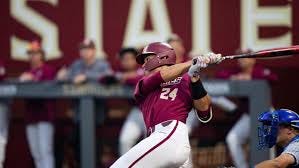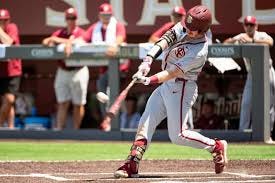Talent is part of it, but it ain't easy.
Seminole stars are now in the money; but reaching the show is tough
For Florida State baseball stars James Tibbs and Cameron Smith, yesterday was the culmination of a dream. When you agree to come to college and see if your game is good enough to interest the major leagues, the very best you can hope for is for one of those 30 big-league teams to reach out and pluck you.
When they think enough of your game to grab you in the first round, well, that means $$$$$. Lots of $$$$$. One of the totally whacky things about professional baseball is there are only two times you can cash in.
First is your signing bonus, that is, whatever a MLB team decides they’re going to offer you for your signature on your first contract. Even though you haven’t so much as gotten an infield single for them, they’re going to hand you some serious cash, assuming that over the next few seasons you’re going to help them win some baseball games and maybe climb all the way to the majors.


From there, the next time you get a chance to make some real money is when you actually reach the major leagues. But to get there, you’ve got to fight. If you’re a kid who signed out of high school for not a whole lot of money and all of a sudden you’re fighting for playing time against a guy who got first-round money, you might be somewhat less inclined to think of him as a teammate, someone you hope does well in every at bat. It might well be the exact opposite.
Welcome to professional baseball. Where there are no guarantees, no promises, no pathway-to-the-majors-ensured. You have to prove it on the field with your performance. Every day.
For James Tibbs and Cameron Smith, being a first rounder will make an enormous contribution to their bank account and give them perhaps that much more of an opportunity to advance in the sport - not because teams LIKE them but because of the investment they made in them.
As much as all of us baseball fans enjoy the game and watch it at every opportunity, the fact remains that it is a cold, hard, nut-cutting business where there is no loyalty, no rewards for being a good teammate or even a good person. It’s about one thing: production. You either produce or you’re gone.
In July of 2021, John was playing for the Pittsburgh Pirates, hitting 5th in their lineup, he was 4th in the National League that month with a .329 average. They were selling T-shirts and sweatshirts with “The Big Nogowski” on them in Pittsburgh (still are!) By mid-August, he was DFA’d, released.
“The Big Nogowski” shirts - still on sale!
Having watched both players’ careers at Florida State, I’m genuinely happy and excited for both of them. Tibbs’ swing impressed me from Day One, I knew he needed to learn to play defense and he did improve - but can still get better. To me, the big thing he’s going to need to learn is how to hit left-handed pitching. He struggled out in Omaha, maybe he was pressing too hard, maybe they found a hole in his swing. We’ll both find out pretty soon.
To me, Cameron Smith had the look, the build of a major-leaguer. After his terrific run up at Cape Cod, he came back to Florida State a different player and showed his remarkable potential with an outstanding season. But he struggled in Omaha, too. As FAMU coach Jamey Shouppe correctly - and honestly - noted, he was MADE for Howser Stadium. The numbers he put up here were impressive but he had a conveniently short right-center and right field to aim at. How will his swing and talents adapt to a different ballpark? It’ll be fun to watch.
If this column seems a bit more sobering than you might expect from someone celebrating the Seminoles’ pair of first-rounders, let me temper that by explaining that I’ve watched professional baseball up close and very personal for a decade. And I’ve seen a bunch of really gifted, absolutely fantastic collegiate players NOT reach the majors. People do not realize the difference between college baseball, even on the highest of levels like Florida State, and pro ball. If it isn’t night and day, it’s close.
If there was a better college player than Jeremy Morris, it could only have been J.D. Drew, who was simply the best college player I ever saw. But Jeremy got stuck in a Yankee system where he just didn’t seem to fit (I saw him up in Norwich, playing once or twice a week behind less-talented players) and he was done at 25.
Ryan Barthelemy, a fantastic Seminole and one of the classiest, smartest players I got to cover, got as far as Double A. Jayce Boyd, a wonderful hitter, a great mentor to my son, got to Triple A and that was it. The list goes on.
Even FSU’s No. 1 overall; draft selection, the great Paul Wilson had a 40-58 lifetime MLB mark. Arm injuries and playing for bad teams dragged down what you might have thought would have been a fabulous major-league career.
Until you see professional baseball up close, day-to-day, game-to-game, season-to-season, you truly do not understand how mind-numbingly difficult this game is at the highest level.
When I think of all the terrific FSU players I got to watch (and know, in some cases), players like Jonathan Johnson, Mickey Lopez, Jeremy Salazar, Jack Rye, David Yocum, Mike McGee and on and on, these were all exceptional FSU players but they didn’t have success at the major league level, if they even got that far.
Unlike the NFL, where if you’re a top-round pick out of college, you seem to have a pretty decent chance of making it, baseball is that much more difficult, even with exceptional talent, like all those players I mentioned.
You have to be healthy, you have to have a bit of luck and most of all, you have to produce. Period. Or they’ll find someone else.
The Oakland Athletics took John in the 34th round on the third day of the draft. At that point, it was a longer than long shot for him to make it to the major leagues. But after Oakland released him, he went to Indy ball, batted over .400 and the Cardinals grabbed him. They landed him in Double A and he produced. They moved him up to Triple A Memphis, told him he didn’t have a position and they’d try to fit him in once in a while. Ten games into the season, he was hitting third and batting. 300.
When the COVID season struck and there were no minor leagues, they kept him in their extended camp in Memphis, facing pitchers who were being called up and he hit .517. He MADE them give him a chance and in August of 2020, he was in a major-league lineup for the first time. Got a hit. Made the team the next year out of Spring Training. But it wasn’t - and will never be - easy.
So I’m very happy for both young men. They made an extraordinary contribution to FSU baseball, they’re both going to be handed a lot of money out of the gate and I’ll be watching to see if they can make it all the way to the show. If they happen to read this column in a quiet moment, I hope it sticks with them. I wish them all the luck in the world. As talented as they are, there’s a long road ahead. And it ain’t gonna be easy.




